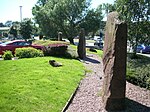Barr Beacon Reservoir
Barr Beacon Reservoir is a covered, hill-top drinking water reservoir at Barr Beacon, Walsall, England, opened in 1899. It is operated by South Staffs Water.One of the uses of the reservoir is to transfer water from the company's works at Hampton Loade, on the River Severn, to Burton upon Trent. Water is pumped uphill from the Sedgley Beacon Reservoirs, which receive water from Hampton Loade, through 45-inch (110 cm) mains to Barr Beacon Reservoir via West Bromwich Booster. A 36-inch (91 cm) main then carries water by gravity via Seedy Mill works to Burton on Trent.The water company also operates a weather station, one of several in its network, at the reservoir, to monitor temperature, hours of sunshine, and rainfall.The reservoir was re-roofed in 1969, temporarily exposing the brick arches which support the roof.In August 2013, Severn Trent Water launched a £2 million project to build a 2 1/2 mile pipeline linking their Perry Barr Reservoir to Barr Beacon Reservoir, to allow for the exchange of water in emergencies such as severe droughts.
Excerpt from the Wikipedia article Barr Beacon Reservoir (License: CC BY-SA 3.0, Authors).Barr Beacon Reservoir
Beacon Road,
Geographical coordinates (GPS) Address External links Nearby Places Show on map
Geographical coordinates (GPS)
| Latitude | Longitude |
|---|---|
| N 52.5756 ° | E -1.91152 ° |
Address
Barr Beacon Reservoir
Beacon Road
WS9 0QN
England, United Kingdom
Open on Google Maps





